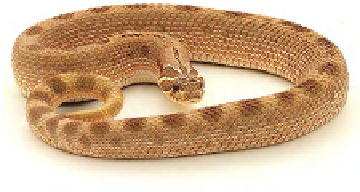Biology Reference
In-Depth Information
(A)
(B)
(C)
(D)
(E)
(F)
Plate 4.91
(A-F) Pattern/phase variants of representative ophidian species popular in
private collections.
(A) Eastern diamondback rattlesnake
(
Crotalus adamanteus
), albino phase.
Clinicians
treating patients presenting with snakebites must remain aware of the increasing availability
(in Europe, the USA, and parts of Asia) of captive bred genetic variants of common venomous
species. Victims may present with snakes that appear markedly different from the normal
phase of a given species such as the albino
C. adamanteus
pictured here. Albinos, leucistics,
melanistics, or other genetically selected phases such as “sunset” can be unfamiliar and
confusing to the treating clinician. It is important to verify the identity of any snake involved
in a presenting snakebite, as this guides critical management decisions that frequently will
directly impact the outcome.
(B and C) Western hognose snake (
H. nasicus
), albino phase variants
. Western hognose
snakes are very popular in private collections, and a variety of phase/pattern variants are






